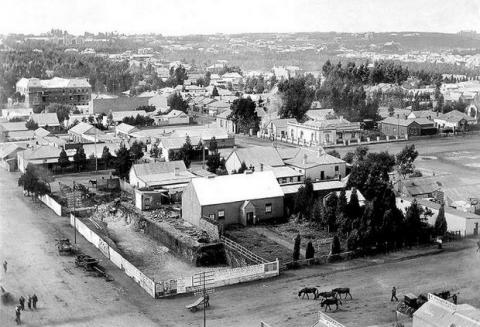Life at Johannesburg (1895)

Johannesburg City Centre.1896
The output is 179,000 ounces a Month and Blacks Must Walk in the Street."Its the greatest gold-mining region in the world," said John
E. Owens, a wellknown newspaper man who has just returned from his travels. He was talking about Johannesburg, and he ought to be
an authority on that corner of the world, for his ramblings in the Transvaal have been extensive.
"Yes," he said, "the greatest gold mines in the world are now at Johannesburg, which, is in the Transvaal, South Africa. It is situated
on a high plateau at an altitude of 5600 feet and 1014 miles from Capetown. Its population of about 60 000 (including the African Blacks)
is decidedly cosmopolitan. Men from all parts of the world have flocked there in their wild rush for gold." He continued :
The mines of Johannesburg (Witwatersrandt, or more commonly known as the "Rand") are now yielding more gold each month than
all the other mines of the world combined. The average monthly output at present is placed at 179,000 ounces. This is continually increasing,
and it is beyond the conception of any person to estimate the possibilities of these mines. To the visitor standing on the small
hill back of Doornfontien, a fashionable suburb of Johannesburg, the sight is a grand one. As far as the eye can reach in a direct line east
and west, the huge chimneys of the gold stamping: mills may be seen blazing forth their fire and smoke. The gold reef is forty-five miles in length.
The first row of deep levels is now in active operation, and before another five years shall have passed by the second, and third
rows of deep level mines will be in active operation. The greater the depth the richer the ore. Some of the mines are now down to a depth
of over 1000 feet. The supply of gold seems to be inexhaustible. It has been estimated by experts that there is a surety of 2,000,000,000 of
gold in the Johannesburg mines. The success of these mines is due solely to Americans. The Australian miners first visited the "Rand,"
but they were unsuccessful. After many attempts, they finally left, stating that no gold could be found in "those fields. English miners
from Cornwall undertook the responsibility. Though they made a better showing than the Australians", yet they were far from giving satisfaction.
The Rothschilds became interested in these fields. They sent out Hamilton Smith, a Californian, to look over the ground and see whether there was
sufficient gold on the reef to warrant an expenditure. His report was a favourable one.
From that time experienced American miners made their appearance at Johannesburg. The place began to assume life from the moment they took charge.
The result is that today, under the management of Americans, mostly Californians, Johannesburg has become the greatest gold center
of the world, and one may find there the very latest improved mining machinery. There is at present over 3500 stamps at work in the mills.
These mills are run at their fullest capacity, night and day, from one week's end to the other. Everything is on a gigantic scale, so far as mining is
concerned. From early morning till late in the afternoon the stock exchange on Commissioner street is a scene of excitement.
If stocks are high then business is good in the town, but if there should be a drop in the market money is scarce. The population
seems to live by gambling.The hope of South Africa Is centered in Johannesburg. Capetown, Port Elizabeth, East London and Natal
are all dependent on the Johannesburg trade. The financial houses of Europe have their representatives at the "Rand." Notwithstanding
this great wealth of gold, South Africa is not the place for a poor man to go for work.
All the labour in the mine's is performed by the African natives. There are no factories nor any opportunity for agricultural work. Living there is extremely expensive,
it being next to an impossibility to get along with less than $100 a month. The influx of population to Johannesburg has been very great.
The result is that at least 5000 men are out of work and starving. A large number are arriving weekly swelling up the list of unemployed and
adding to the general confusion.
Among the most notable Americans who have been the means of building up Johannesburg may be mentioned: Charles Butters,
the introducer of the cyanide process there; J.H.Hammond, who receives the fabulous salary of $125,000
per annum; Captain Mein of the Robinson miner; Hamilton Smith, representing the Rothschilds; Mr. Webber of the Crown Reef;
Mr. Wiltse of the Glendenhuis estate, and J. C. Manion, representing American firms.
Johannesburg may be considered as one of the wonders of the mining world. Its growth has been phenomenal nine years ago the site of the "Rand" had but one habitation.
Today the town has magnificent office buildings and palatial residences. The feeling here between the English and the Boers is very bitter.
How long the Transvaal Government will last, is very hard to guess. One thing is certain, that the population of Johannesburg (excepting the Americans) are
ready to revolt whenever an opportunity occurs. The police force of Johannesburg may be considered as one of the most incompetent in existence.
Africans, Indians, Chinamen, and all who have black or Asiatic blood in their veins, must walk in the middle of the road. The sidewalks are for the use of the whites in Boerland.
Any of these above persons caught walking on the sidewalks are arrested and fined $10 or one month. It is a peculiar country with a peculiar people.
San Francisco Call, 29 June 1895